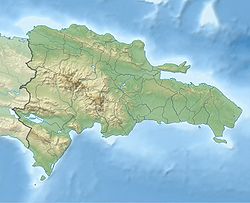- Salcedo, Hermanas Mirabal
-
Salcedo Coordinates: 19°25′12″N 70°23′24″W / 19.42°N 70.39°WCoordinates: 19°25′12″N 70°23′24″W / 19.42°N 70.39°W Country  Dominican Republic
Dominican RepublicProvince Hermanas Mirabal Area[1] – Total 432.95 km2 (167.2 sq mi) Elevation[2] 196 m (643 ft) Population (2002)[3] – Total 40,510 – Density 93.6/km2 (242.3/sq mi) – Urban 11,994 – Demonym Salcedense Distance to
– Santo Domingo
160 kmMunicipalities 1 Salcedo is the capital city of the Hermanas Mirabal Province in the Dominican Republic.
It is famous for being the birthplace of the Dominican heroines, the Mirabal sisters who gave their lives in the struggle against the dictator Rafael Trujillo. There is a museum in the town, Ojo de Agua (lit. Water Eye but also spring) commemorating three of sisters who were killed in the struggle against dictatorship. It is tended to by the remaining sister, Bélgica (Dedé) Mirabal.
The city is named after Francisco Antonio Salcedo who fought in the northwestern part of the country against the Haitian army during the Dominican-Haitian War after the Dominican independence from Haiti in 1844.
Contents
Geography
Salcedo is located in the Cibao Valley, south of the Cordillera Septentrional (in English, "Northern mountain range"). It has a total area of 432.95 km².[1] It has only one municipal district (a subdivision of a municipality): Jamao Afuera.[4]
Population
The municipality had, in 2002, a total population of 40,510: 20,366 men and 20,144 women. The urban population was 29.6% of the total population.[3] In this numbers are included the population of Jamao Afuera municipal district.
History
In the place where is now the city of Salcedo there was a very small town with the name of Juana Núñez. It was made a Puesto cantonal (an old category that now is called Municipal District) in 1880 as part of the old La Vega province.[5]
With the creation of the Espaillat province in 1885, Juana Núñez was made part of this new province. In 1891, its name was changed from Juana Núñez to the present one, Salcedo.
Salcedo was made a municipality in 1905 and, when the Salcedo Province (now Hermanas Mirabal Province) was created in 1952, the city became the head municipality of the new province.
Economy
Farming is the only economic activity in the municipality, except for some very small industries; the main products are plantain, cassava and cacao.
Sister cities
References
- ^ a b Superficies a nivel de municipios, Oficina Nacional de Estadistica
- ^ De la Fuente, Santiago (1976) (in Spanish). Geografía Dominicana. Santo Domingo, Dominican Republic: Editora Colegial Quisqueyana.
- ^ a b Censo 2002 de Población y Vivienda, Oficina Nacional de Estadistica
- ^ Oficina Nacional de Estadística. "División Territorial 2008" (in Spanish) (PDF). http://www.one.gob.do/index.php?module=uploads&func=download&fileId=1098. Retrieved 2009-10-01.
- ^ Pouerié Cordero, M.M (1997) (in Spanish). Síntesis de ciudades, pueblos e islas del país. Santo Domingo, Dominican Republic: Impresora Mary.
Provincial capitals of the Dominican Republic Azua · Baní · Barahona · Bonao · Comendador · Cotuí · Dajabón · El Seibo · Hato Mayor · Higüey · Jimaní · La Romana · La Vega · Mao · Moca · Monte Cristi · Monte Plata · Nagua · Neiba · Pedernales · Puerto Plata · Sabaneta · Salcedo · Samaná · San Cristóbal · San Francisco de Macorís · San José de Ocoa · San Juan de la Maguana · San Pedro de Macorís · Santiago de los Caballeros · Santo Domingo · Santo Domingo Este
 Categories:
Categories:- Hermanas Mirabal Province
- Populated places in the Dominican Republic
- Municipalities of the Dominican Republic
- Dominican Republic geography stubs
Wikimedia Foundation. 2010.

